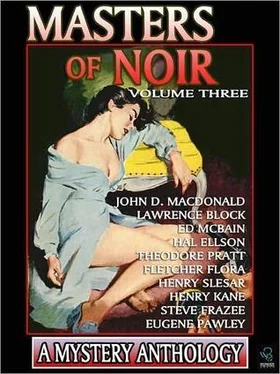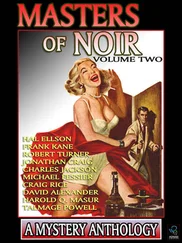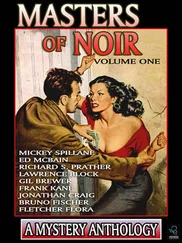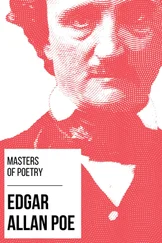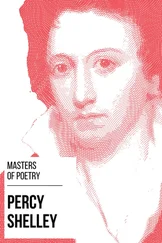Хал Эллсон - Masters of Noir - Volume 3
Здесь есть возможность читать онлайн «Хал Эллсон - Masters of Noir - Volume 3» весь текст электронной книги совершенно бесплатно (целиком полную версию без сокращений). В некоторых случаях можно слушать аудио, скачать через торрент в формате fb2 и присутствует краткое содержание. Город: Northville, Год выпуска: 2010, ISBN: 2010, Издательство: Wonder Publishing Group, Жанр: Детектив, на английском языке. Описание произведения, (предисловие) а так же отзывы посетителей доступны на портале библиотеки ЛибКат.
- Название:Masters of Noir: Volume 3
- Автор:
- Издательство:Wonder Publishing Group
- Жанр:
- Год:2010
- Город:Northville
- ISBN:978-1-61013-051-6
- Рейтинг книги:5 / 5. Голосов: 1
-
Избранное:Добавить в избранное
- Отзывы:
-
Ваша оценка:
- 100
- 1
- 2
- 3
- 4
- 5
Masters of Noir: Volume 3: краткое содержание, описание и аннотация
Предлагаем к чтению аннотацию, описание, краткое содержание или предисловие (зависит от того, что написал сам автор книги «Masters of Noir: Volume 3»). Если вы не нашли необходимую информацию о книге — напишите в комментариях, мы постараемся отыскать её.
Masters of Noir: Volume 3 — читать онлайн бесплатно полную книгу (весь текст) целиком
Ниже представлен текст книги, разбитый по страницам. Система сохранения места последней прочитанной страницы, позволяет с удобством читать онлайн бесплатно книгу «Masters of Noir: Volume 3», без необходимости каждый раз заново искать на чём Вы остановились. Поставьте закладку, и сможете в любой момент перейти на страницу, на которой закончили чтение.
Интервал:
Закладка:
3.
Ben Eglin had a long, narrow cubbyhole off the homicide detail room.
“They’re both in the apartment,” said Jordan, “or were when I left this morning. And some salesman or other came.”
Eglin nodded. “Who was the other girl you mentioned?”
“Name’s Gloria Hume. Bart thought Crider sent her. I do, too. Last night everybody was conning everybody. It was great.”
Eglin wrote down the name. He pushed across an open folder file. It was almost two inches thick. “Read it,” he said. “Take it out in the detail room.”
Jordan picked up the file. He felt Eglin’s eyes on him steadily. It was a somehow different stare, not pushing or demanding. Jordan stared back resentfully. To his surprise Eglin dropped his gaze.
Looking down at the desk, Eglin said, “How did you manage it so fast with the Berkey girl?”
Jordan grinned at Eglin’s male curiosity. “Trade secret,” he said.
In the detail room he took the first empty desk he found. There were a half-dozen men around, some on the telephone, some writing. Eglin’s detail. They knew who he was and what he was doing. And they seemed contemptuous of him.
He opened the folder and riffled through the file. This was his first look at a murder file. Report of the coroner’s deputies. The autopsy surgeon’s report. Photographs. Measurements on the position of Bob Garfield’s body. A question and answer statement of the citizen who looked down the alley by chance and first saw the body. Maps. Measurements on the interior of Crider’s cigar store. Ballistics on a .32 calibre bullet. A pathologist’s finding on submitted samples. Reports by Inspectors Tague, Barry, Furlong, Maloof; there were others. And statements. A great sheaf of question and answer statements, free and voluntary, by Crider, Elsa Berkey, Bart Berkey and somebody named James Lombard. All taken by Bernard Eglin, chief homicide inspector.
At the end of an hour Jordan was only half finished but he had, for the first time, a physical picture of the murder scene in his mind. And he began to understand a little of Ben Eglin’s rage.
Crider called it Store No. 1 because he started there. It fronted on School. Alongside it ran Romar Terrace, which was an alley dignified by a name. The store had two rooms. The front was typical — cigars, cigarettes, candy and gum racks, magazine racks, three pinball machines, a claw machine, shaving gear, paper back novels. The other room was directly behind. Shelves for storage. A desk in a corner that Crider sometimes used. A long table. And five telephones. A side door opened from this back room onto the alley. You stepped directly out to the narrow sidewalk. There, in the gutter opposite the door, Bob Garfield’s body lay. And there, on the sidewalk an inch beyond the sill, the one drop of Garfield’s blood was found.
Garfield lay on his back, stretched at length. His cap was a foot from his head. His service revolver was holstered and unfired. Blood stained his blouse around the single chest wound. But there was no blood beneath him. No blood around him. No blood anywhere except that single drop. Garfield had not died there at all.
There was no blood in the store, anywhere — floors, walls, furniture or stock — according to the pathologist. Jordan could see in the reports the mounting fury of Eglin as he sent his men back to search again and again. No blood — and without it no proof, beyond that single drop, that Garfield had been killed in the store and his body carried out to the alley.
Jordan turned to the question and answer statements. Crider first. They had found him in bed at two that morning. His statement was taken at three. He was cool and seemingly frank. No, he owned no gun. Yes, he was there that night. He made it a habit to drop around to his stores just before closing time. Bart Berkey was just shutting up shop when Crider reached Store No. 1. Crider checked the cash register. They turned off the lights and said good night at the door. That was all. A quiet night. He didn’t see Bob Garfield. Or anyone else.
Those five telephones were his bookie business — he wouldn’t try to kid Inspector Eglin. His clerks took horse bets at every store except No. 1. They passed them along by phone to the back room of Store No. 1. James Lombard took them there. No, Lombard was not there that night. He left at seven.
Pay ice to Bob Garfield? Inspector Eglin should know better than that. The clerks were paid to take their chances. Sometimes they got knocked over by the department. Look at the arrest records; they prove it. The business wasn’t worth protection money. Garfield was clean, and a friend. Was Garfield interested in Elsa Berkey? Maybe. Who wouldn’t be? She was a good-looking red-head. Me? No, thanks — a smart man never fools around with his own women employees.
That was the meat of Crider’s first statement. Underneath it was another, and another. And yet another. Eglin wouldn’t give up. But Crider’s fourth story didn’t vary from his first.
Next, Elsa Berkey. She was more terse than Crider. She volunteered nothing. She answered carefully. Started working for Crider two years ago. Before that a singer in a night club. That throaty voice should do all right with a blues song. Six months ago she got Bart a job with Crider. She opened Store No. 1 in the morning, Bart closed it at night.
She knew Bob Garfield. She had gone out with him. How many times? Three, perhaps four. They were just friends. Did he mention the telephones in the back room? No. Positive, Miss Berkey? Of course. No, there was nothing between her and Crider. There never had been. He was her employer.
Come now, Miss Berkey. The facts are against you. You admit you got Bart his job. Bart isn’t what you’d call good material for a cigar-store clerk. Crider would never have hired him if there hadn’t been something in it for Crider.
There was a bargain, but not that kind. A pretty girl helped business in a store where the customers were men. She knew hundreds of them by their first names. They bought there because of her. Bart had a good mind. But he was — well, he lived in a shell. She knew she had to make him break out of it. She had to make him meet people, deal with people. She asked Crider to put him to work. Crider refused. She quit. She thought that would make Crider give Bart a job. It did. Bart got the job on the condition that she come back.
Jordan stopped reading. She used her sex, all right, to get Bart a job. But it was the way she said, not the way Eglin said. It was just like last night, he thought, when she used her sex on me in an attempt to protect Bart. Everything she does is for Bart.
Then he knew what had happened to him. He had started believing her. Why? Maybe it was the cool, honest way she used her sex, without pretense or hypocrisy. He went back to the file, reading rapidly. There wasn’t much more. She was in bed when Bart came home that night. She heard him but she did not look at the clock.
Ban Berkey’s fear came through the very first words of his first statement. The stenographer taking it down had asked him to speak louder. Eglin had been reassuring. Eglin told him he had nothing to fear.
Ban was telling Crider’s story — the exact same story. Eglin had turned harsh. A fourth statement had been taken that night. A fifth at nine the next morning. Eglin was pitiless. A sixth and last had been taken yesterday. The time was just one hour before the old relief, Dennehy, had walked out into the intersection at Berkeley and Trimount and told Jordan he was wanted at the station.
As Jordan dug into this last statement the cold words took on tension and the scene came alive. He could see Eglin leaning forward, pinning the frightened Bart to the chair with those eyes.
Q: Your sister’s no good, Berkey. She messes up men. You going to let her go on getting you in trouble all your life?
Читать дальшеИнтервал:
Закладка:
Похожие книги на «Masters of Noir: Volume 3»
Представляем Вашему вниманию похожие книги на «Masters of Noir: Volume 3» списком для выбора. Мы отобрали схожую по названию и смыслу литературу в надежде предоставить читателям больше вариантов отыскать новые, интересные, ещё непрочитанные произведения.
Обсуждение, отзывы о книге «Masters of Noir: Volume 3» и просто собственные мнения читателей. Оставьте ваши комментарии, напишите, что Вы думаете о произведении, его смысле или главных героях. Укажите что конкретно понравилось, а что нет, и почему Вы так считаете.
